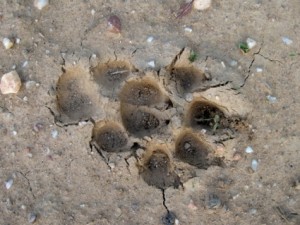
Photo © Michael Sommers.
At the Jaguar Ecological Reserve, my sister, Annie, and I spent our first night listening to tables full of travelers buzzing about jaguars during dinner. A group of gringos and their guide, who had spent the day at nearby Porto Jofre, passed around a digital camera with fuzzy shots of a faraway feline. They were beaming with delight. Jaguars were at the back of everybody’s thoughts and on the tip of everyone’s tongues as they struck up conversations with strangers.
Searching for jaguars is like searching for gold; seekers can easily get obsessed.The following day, the Jaguar Reserve’s guide, Tom, took us walking through the brush in search of onças. Tom is from Poconé, but many of his relatives—including Eduardo Falcão, owner of the Jaguar Ecological Reserve–are Pantanal cattle ranchers. As a result, college-age Tom grew up spending all his holidays in the bush. Over the years, he has seen dozens of jaguars in an endless and enviable array of contexts. Fighting. Purring. Coupling. Hunting. Feeding. Dragging cattle carcasses. Nursing cubs. Using trees as scratching posts. “The only thing I’ve never seen is a jaguar giving birth,” he admitted. Despite his many viewings, he assured us that the thrill of running into a jaguar never wears off.
Searching for jaguars is like searching for gold; seekers can easily get obsessed. Tom took us to a wooded site where only 5 days before a couple of cats had been spotted – and told us about the “Americano” who had dangerously pitched a tent there, vowing not to budge until he hit the jaguar jackpot.
To break the tedium, the Americano ate his breakfast at the Jaguar Reserve. On the third day, after polishing off his meal, he returned to his campsite and was stunned to find a jaguar in front of his tent, rolling around and purring like an overgrown tabby. Euphoria overcoming any rational fears, he immediately began shooting photos and videos of the big cat, before breaking down and running back to the pousada where, weeping with joy, he handed out gigantic tips to all the staff.
That night at dinner, there were fewer guests and the mood was more subdued. We hadn’t caught sight of our jaguar and neither had the tourists who had spent that day at Porto Jofre, combing the banks of the Rio Cuiabá.
Jean, a Haitian who had emigrated to Brazil, and had spent the last 15 years working as a guide in the Pantanal, told us that the jaguars would now be more difficult to see on account of the rain that had fallen two days earlier. The first rain of the wet season, it had summoned enough mosquitoes and other irritating bugs to drive the jaguars into the bush. Instead of lolling around in one spot where they’d get bitten and stung, the onças would now be on the move.
“In the end, you never know when you’ll see a jaguar,” mused Jean. “I never give tourists odds or statistics. Ultimately, the longer you stay in the Pantanal, and the more you move around, the better your chances are of running into one – or of one running into you.”
Our last day at the Jaguar Reserve, we woke up knowing that our chances of seeing a jaguar were razor thin. Over breakfast, Annie and I admitted to each other that, unlike many jaguar-obsessed travelers we had met over the last several days, we were totally at peace with our Jaguar Challenged status. After all, we had come face to face with howler and capuchin monkeys, capybaras, marsh deer, a multitude of birds, rivers filled with caimans, and – in a stroke of luck that would help us impress-the folks back home – a gigantic, B-film-worthy, 30-foot anaconda. We had also spent three days in one of the most remote and fantastic landscapes on the planet.
For our last hike, Tom took us to an abandoned IBAMA research station. The previous week, jaguars had been seen prowling around amidst the abandoned laboratories. When we arrived, the only thing we encountered were a couple of metallic blue butterflies and a chorus of invisible cicadas, whose shrill piercing hum announced rain.
On the way back, walking along the Transpantaneira, Annie let out an excited gasp. On the edge of the road, deeply engraved in the dried red mud, were the large paw prints of a gigantic cat or, more precisely, of a fair-sized jaguar.
Although it wasn’t the beast itself, it was something. A sign. A connection.
There was a strange sacredness about the prints; they were a testament to the jaguar’s strong presence – and to its ultimate elusiveness.
“Sometimes, a guide will be walking with a tourist and see a jaguar, and by the time the tourist turns and looks, it’s gone,” said Tom. “It’s all so sudden that some tourists get angry and accuse the guide of pulling a scam. To prove he’s not lying, the guide shows the tourists the prints.”
“All these people come to the Pantanal crazy to see jaguars,” continued Tom. “But in the Pantanal we have a saying: ‘The jaguar only reveals himself to those he chooses.”
Read the previous part of this article.